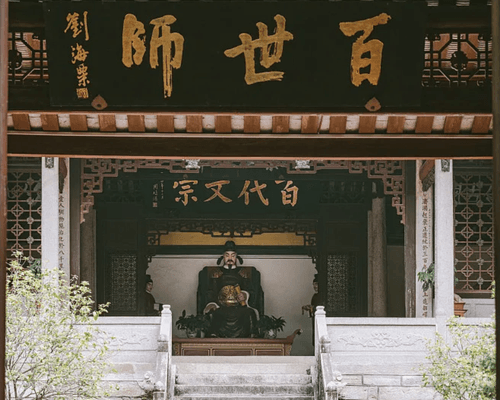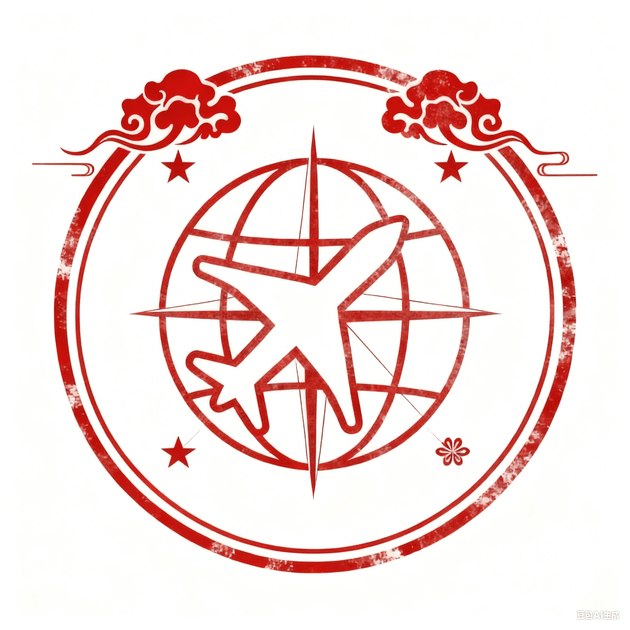
Han Yu Ancestral Shrine: How an "Exiled" Scholar Forever Changed the Identity of Chaozhou
Dear traveler, when you visit Chaozhou (Teochew), a historical and cultural city in China, you will undoubtedly be captivated by the sights: the magnificent Guangji Bridge spanning the Han River, the elegant, ancient streets lined with memorial arches (Pai-fang Street), and the air rich with the fragrance of Gongfu tea and local delicacies.
However, on the eastern bank of the Han River, at the foot of Bijia Mountain (now aptly renamed Han Mountain), sits an ancient structure—the Han Yu Ancestral Shrine (Han Wen Gong Ci). This is arguably Chaozhou’s most crucial cultural landmark. For many visitors, the concept of an "Ancestral Shrine" might be unfamiliar. Simply put, it is not a religious temple, but rather a "Hall of Heroes" or a memorial built by the people of Chaozhou to honor a truly extraordinary historical figure.
The hero being commemorated is Han Yu (768–824 AD).
What makes this story truly astonishing is that this great scholar and official from the Tang Dynasty only stayed in Chaozhou for a mere eight months. So, what exactly did he do to earn such profound, enduring respect that the local people renamed their most important river the “Han River” and their mountain the “Han Mountain,” and have honored him for centuries as “Our Chaozhou Mentor”?
This article will guide you through the history, art, culture, and travel aspects of the Han Yu Ancestral Shrine, revealing the fascinating, thousand-year-old bond between this "exiled hero" and the land of Chaozhou.
Part I: History—An Official's "Five-Thousand-Mile Exile" and an "Eight-Month Miracle"
To truly appreciate the shrine, we must first address the central question: “What was Han Yu famous for?”
Han Yu is celebrated as one of the most influential literary figures and thinkers of the Tang Dynasty. He is revered as the “Foremost of the Eight Great Prose Masters of the Tang and Song Dynasties.” He led the "Classical Prose Movement," which rescued Chinese writing from overly elaborate and empty styles, injecting it instead with simplicity, strength, and practical purpose. Ideologically, he was a staunch Confucian scholar, advocating for governance rooted in morality and education.
The Road to Exile: The Integrity of a Scholar
In 819 AD, Han Yu courageously submitted a memorial to Emperor Xianzong, vehemently opposing the Emperor's grand ceremony to welcome and revere the relic of the Buddha's finger bone. Han Yu saw this as harmful superstition. His bold advice infuriated the Emperor, almost costing Han Yu his life. He was ultimately condemned and sent into exile—a political banishment known in Chinese as bǐn zhé—to the distant territory of Chaozhou, which was then considered a wild, "barbaric" frontier plagued by disease and hardship.
The journey was described by him as a "banishment of five thousand miles (eight thousand lǐ)," filled with desperation. Yet, this seemingly tragic exile became the foundation of Han Yu's eternal fame and fundamentally reshaped Chaozhou's destiny.
The Chaozhou Governance: Eight Months of Staggering Achievement
Instead of wallowing in despair, Han Yu embraced Chaozhou as a stage to implement his Confucian ideals. In his short eight-month tenure, he accomplished three feats that secured his legacy:
Taming the Crocodiles, Saving the People:
The local river was then known as the "Evil Creek" (È Xī), a terrifying name that reflected the locals' fear. It was infested with crocodiles that frequently attacked and killed people and livestock. Han Yu personally went to the riverbank and composed the famous Ode to the Crocodiles (Jì È Yú Wén), an official declaration that blended humanist concern with magisterial authority, ordering the creatures to leave. Whether through the power of his words or the organized efforts to eradicate them, historical accounts state that the crocodile menace vanished. In gratitude and commemoration, the people of Chaozhou renamed the "Evil Creek" to the "Han River." This was a victory of civil authority and wisdom over nature's terror.
Igniting Education, Sowing the Seeds of Civilization:
This is Han Yu's single greatest contribution. Recognizing the region's lack of formal learning, he immediately set about revitalizing the local state school. To encourage and fund this crucial effort, he famously donated his entire eight months' salary in Chaozhou. He bravely appointed the local sage Zhao De to oversee the school, introducing the advanced culture and Confucian principles of the Central Plains to this remote region.
Freeing the Enslaved, Implementing Benevolent Rule:
He also worked to free people who had been unlawfully taken as slaves by local powerful families, easing social tension and establishing a precedent for just and humane governance (rén zhèng).
Han Yu's "Eight-Month Miracle" transformed Chaozhou from a remote outpost into a culturally flourishing region, earning it the nickname "Zou-Lu by the Sea" (a reference to the birthplace of Confucius and Mencius). This cultural revival eventually led to a dramatic increase in successful candidates in the imperial civil service exams, or "Keju" (a system of meritocratic government recruitment), during the subsequent Song Dynasty.
Part II: Culture and Art—A Millennium-Old Spiritual Beacon
As a centuries-old shrine, the Han Yu Ancestral Shrine is not just a vessel for Han Yu’s spirit, but also a showcase of traditional Chaozhou culture and art.
The Majesty of the Architecture and Artistry
The first shrine was built in the Song Dynasty (999 AD), and the current location on Han Mountain dates back to 1189 AD. The architecture is a prime example of the traditional Chaozhou shrine style: built into the hillside, facing south, combining a majestic yet simple dignity.
The Art of Tile-Cutting: Pay close attention to the rooftop and walls. You will see exquisite examples of Chaozhou Cut-Porcelain Mosaic (Qiàn Cí). This unique architectural decoration involves cutting colorful porcelain fragments and meticulously pasting them to form flowers, birds, figures, and auspicious patterns. The intricate details and vivid colors are a testament to the sophisticated craftsmanship of the Lingnan region.
A View of Auspicious Fengshui: The shrine’s location is a fengshui (geomantic) masterpiece, backed by Han Mountain and overlooking the Han River. From the highest point, the Shi Lang Pavilion (named after Han Yu’s title of Ministry of Justice Vice Minister), you can look out over the entire Chaozhou Old City and the Guangji Bridge, absorbing the truly magnificent feeling that the "rivers and mountains now bear the Han surname."
The Treasure Trove of History—The Stele Corridor
The most significant cultural value of the shrine lies in its extensive collection of historical stone tablets, or steles (currently about 40 pieces). These not only chronicle the history of the shrine and Han Yu's governance but are also masterpieces of Chinese calligraphy.
The most famous piece is the inscription written by another great Song Dynasty literary master, Su Shi (Su Dongpo), titled “Stele Inscription for the Temple of Han Yu in Chaozhou.” In this text, Su Shi praised Han Yu by saying his writing "saved the decline of eight dynasties (of prose)" and his morality "saved the world from drowning." This stele is considered a cultural and calligraphic treasure.
One of the "Eight Scenic Views of Chaozhou": Han Shrine Oak
Around the shrine, you will find a venerable old tree—the famous “Han Shrine Oak” (Han Ci Ruò Mù), one of the "Eight Scenic Views of Chaozhou." Legend holds that when Han Yu was exiled, he brought two oak saplings from his home region and planted them here; only one survived.
This ancient oak is seen as a living symbol of the cultural seeds Han Yu planted in Chaozhou. Surviving for over a thousand years, it represents the enduring and vibrant respect the people of Chaozhou hold for their ancient mentor.
Part III: The Visit—Connecting with the Power of a Mentor
For international travelers, visiting the Han Yu Ancestral Shrine is not just sightseeing; it is an immersive dialogue with the core spirit of Chinese history and culture.
Planning Your Trip: The Ascent to Wisdom
Arrival: The shrine is located on the East Bank of the Han River. We recommend visiting after seeing the Guangji Bridge, perhaps after witnessing the daily spectacle of the central floating bridge being opened and closed.
The Climb: Upon reaching the main entrance, you must ascend a set of stone steps. These steps are not random; there are 56 of them, deliberately commemorating Han Yu’s life: he was exiled to Chaozhou at age 51, served there for 1 year, and passed away at age 56. Every step you take is a symbolic measure of this historical figure's journey and legacy.
Reflection and Reverence: Inside the main hall, you can observe Han Yu’s statue. Take a moment to read the inscriptions and plaques on the walls, appreciating the ancient Chinese tradition of shidafu (scholar-official) spirit—the deep sense of social responsibility felt by the educated elite.
The View from the Pavilion: Be sure to climb to the Shi Lang Pavilion. From this vantage point, the whole of the Chaozhou Old City unfolds before you, embraced by the ribbon-like Han River. It is here that you will truly grasp the meaning of “the rivers and mountains now bear the Han surname”—it is not mere name-changing, but a powerful, spiritual acknowledgment passed down through generations.
Bridging the Cultural Gap: Understanding the Reverence
To fully appreciate this thousand-year-old reverence, which may feel distant from Western thought, try to view Han Yu as a "Cultural Pioneer" and an "Enlightenment Hero." Through his intense, eight-month effort, he proved that the power of education and morality could fundamentally change the destiny of an entire region. What he gifted the people of Chaozhou was not just a school, but a spirit of intellectual curiosity, moral integrity, and active civic duty.
The Han Yu Ancestral Shrine stands as a monument to this powerful spirit—one of bringing culture and enduring benevolence to the masses.
The next time you enjoy the food or admire the traditional crafts of Chaozhou, remember that the foundation of this prosperity was laid over a thousand years ago by an exiled scholar who invested his salary, his pen, and his whole heart into sowing the seeds of civilization.
A visit to the Han Yu Ancestral Shrine is a journey to the enduring source of Chaozhou’s soul.


